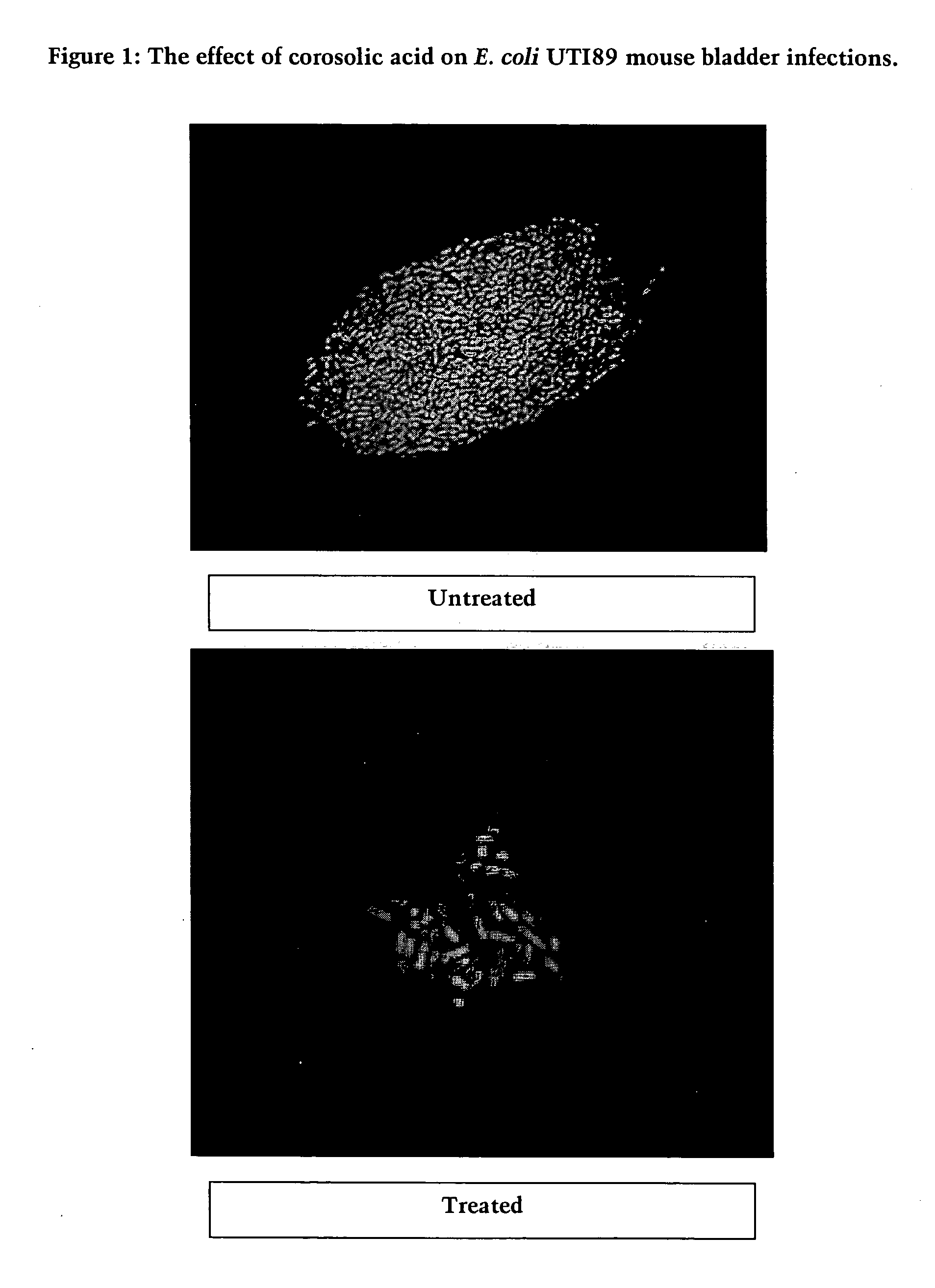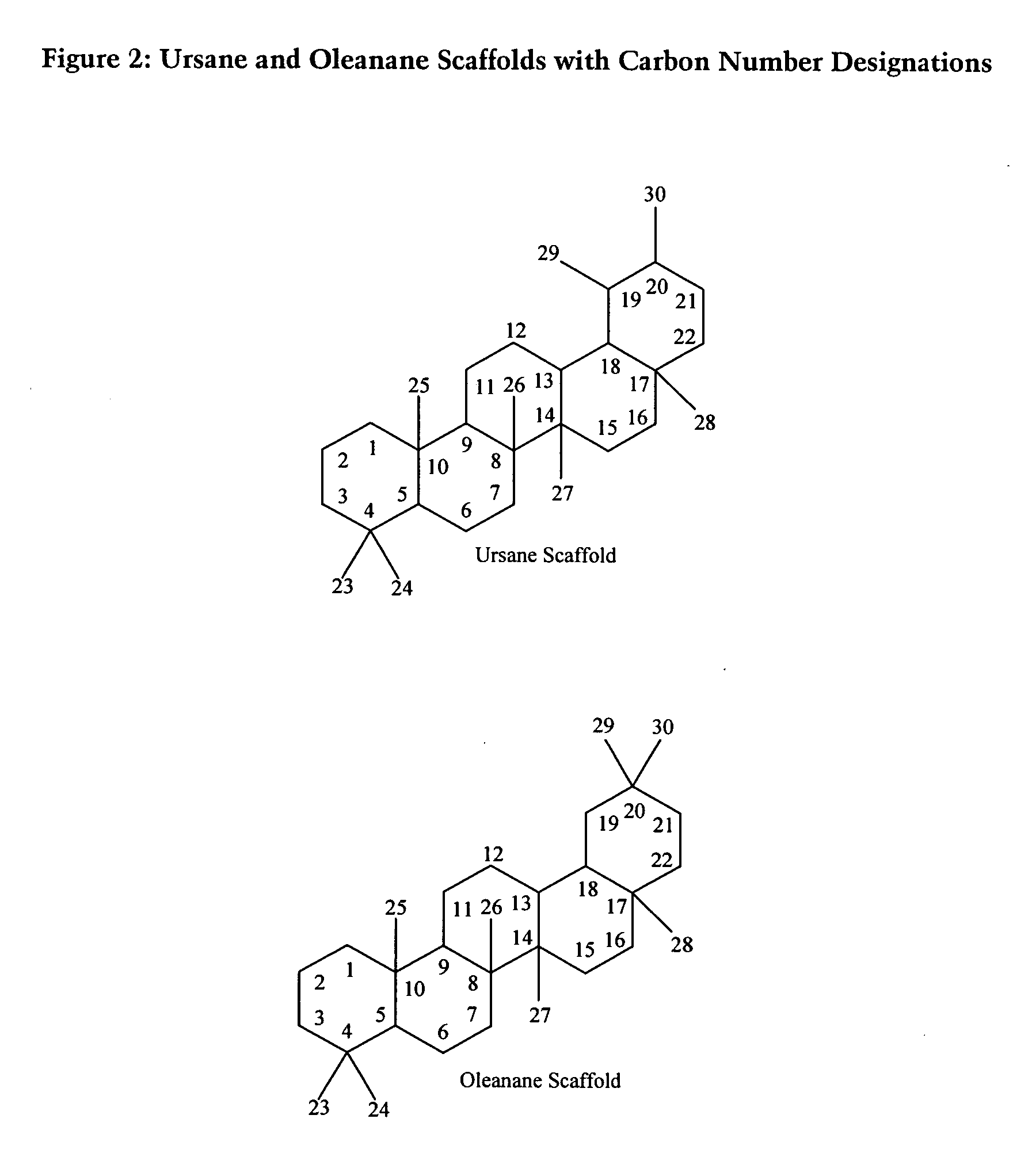Compositions and methods for controlling biofilms and bacterial infections
a technology of biofilms and bacteria, applied in the field of compositions and methods for controlling biofilms and bacterial infections, can solve the problems of serious medical problems involving chronic infections involving biofilms, serious threats to animal health, especially human health, and the ineffective treatment of chronic infections of antibiotics derived from the nccls method
- Summary
- Abstract
- Description
- Claims
- Application Information
AI Technical Summary
Benefits of technology
Problems solved by technology
Method used
Image
Examples
example 1
[0144] Inhibition of Biofilm Formation by Asiatic acid, Corosolic acid, and Madecassic acid: Escherichia coli clinical strain UT189 and laboratory strain JM109 Assays.
[0145] Biofilm inhibition experiments were conducted using an assay adapted from the reported protocol described in Pratt and Kolter, 1998, Molecular Microbiology, 30: 285-293; Li et al., 2001, J. Bacteriol., 183: 897-908. E. coli clinical strain UT189 was grown in LB in 96 well plates at room temperature for one or two days without shaking. E. coli laboratory strain JM109 was grown in LB plus 0.2% glucose in 96 well plates at room temperature for one day without shaking. To quantify the biofilm mass, the suspension culture was poured out and the biofilm was washed three times with water. The biofilm was stained with 0.1% crystal violet for 20 minutes. The plates were then washed three times with water. OD reading at 540 nm was measured to quantify the biofilm mass at the bottom of the wells. Then 95% ethanol was adde...
example 2
[0147] Inhibition of Biofilm Formation by Pygenic acid A, Pygenic acid B, 3-acetyl oleanolic acid and Echinocystic acid: Pseudomonas aeruginosa PA01 Assays.
[0148] An overnight culture of P. aeruginosa PA01 in LB+1% citrate was prepared. It was incubated at 37° C. shaker for 24 hours. A 1:20 dilution of the overnight culture was prepared. Test compounds are diluted appropriately with a volume of ethanol followed by shaking for approximately 5 minutes and then diluted with an appropriate volume of water.
[0149] Replicate 96-well plates are prepared, preferably two to four replicates, with appropriately diluted overnight culture and test compound in each well. Preferably, test compounds are prepared at 10 to 30 micrograms per milliliter. On each 96-well plate controls are appropriately prepared with at least one set of controls consisting of overnight culture and ethanol / water diluent and another set of controls consisting of growth media and ethanol / water diluent. Plates are covered ...
example 3
[0153] A General Procedure for Isolating Compounds of Interest from Plant Samples
[0154] For purposes of illustration, the following provides a non-limiting example of a general procedure that may be employed to isolate and purify the compounds described herein. First, an extraction step may be carried out by grinding dried plant material to a homogenous powder and sonicating the powder in an organic solvent, such as a mixture of ethanol: ethanol acetate (50 EtOH: 50 EtOac), and shaking the resulting mixture vigorously for exhaustive extractions. Next, flash chromatographic separation may be carried out by dissolving the organic extract in 5 mL of a solvent, such as methanol: ethyl acetate (MeOH:EtOAc) (50:50), adsorbing it onto silica powder and bringing the dried powder onto a silica column and eluting on the flash chromatography system using a step gradient of (1) 75% hexanes, 25% ethyl acetate, (2) 50% hexanes, 50% ethyl acetate, (3) 100% ethyl acetate, (4) 75% ethyl acetate, 25...
PUM
 Login to View More
Login to View More Abstract
Description
Claims
Application Information
 Login to View More
Login to View More - R&D
- Intellectual Property
- Life Sciences
- Materials
- Tech Scout
- Unparalleled Data Quality
- Higher Quality Content
- 60% Fewer Hallucinations
Browse by: Latest US Patents, China's latest patents, Technical Efficacy Thesaurus, Application Domain, Technology Topic, Popular Technical Reports.
© 2025 PatSnap. All rights reserved.Legal|Privacy policy|Modern Slavery Act Transparency Statement|Sitemap|About US| Contact US: help@patsnap.com



